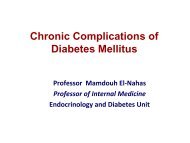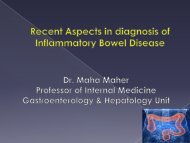Assessment of some biochemical tests in liver diseases
Assessment of some biochemical tests in liver diseases
Assessment of some biochemical tests in liver diseases
You also want an ePaper? Increase the reach of your titles
YUMPU automatically turns print PDFs into web optimized ePapers that Google loves.
<strong>Assessment</strong> <strong>of</strong> <strong>some</strong> <strong>biochemical</strong> <strong>tests</strong><br />
<strong>in</strong> <strong>liver</strong> <strong>diseases</strong><br />
By<br />
Pr<strong>of</strong>. Mohamed Sharaf-Eld<strong>in</strong><br />
Pr<strong>of</strong>. <strong>of</strong> Hepatology & Gastroenterology<br />
Faculty <strong>of</strong> Medic<strong>in</strong>e<br />
Tanta University, Egypt.
Significant <strong>liver</strong> damage may occur <strong>in</strong><br />
patients who have normal f<strong>in</strong>d<strong>in</strong>gs on<br />
<strong>liver</strong> function <strong>tests</strong>.<br />
Biochemical screen<strong>in</strong>g <strong>of</strong> healthy,<br />
asymptomatic people has revealed that<br />
up to 6% have abnormal <strong>liver</strong> enzyme<br />
levels.
Liver Function Test<br />
Interpretation must be performed with<strong>in</strong><br />
the context <strong>of</strong> the patient’s risk factors,<br />
symptoms, concomitant conditions,<br />
medications, and physical f<strong>in</strong>d<strong>in</strong>gs<br />
Rarely provide specific Dx, but rather<br />
suggest a general category <strong>of</strong> <strong>liver</strong><br />
disease<br />
Differ<strong>in</strong>g laboratories differ<strong>in</strong>g<br />
normal values
LFT’s<br />
Markers <strong>of</strong> hepatocellular damage<br />
Cholestasis<br />
Liver synthetic function
Liver Function Test<br />
Advantages<br />
• sensitive, non<strong>in</strong>vasive<br />
method <strong>of</strong> screen<strong>in</strong>g <strong>liver</strong><br />
dysfunction<br />
• pattern <strong>of</strong> laboratory test<br />
abnormalities to recognize<br />
type <strong>of</strong> <strong>liver</strong> disorder<br />
• assess severity <strong>of</strong> <strong>liver</strong><br />
dysfunction<br />
• follow cause <strong>of</strong> <strong>liver</strong><br />
disease<br />
Disadvantages<br />
• lack sensitivity<br />
– normal results <strong>in</strong> serious<br />
<strong>liver</strong> disease<br />
• not specific for <strong>liver</strong><br />
dysfunction<br />
• seldom lead to specific<br />
diagnosis
Liver Function Test<br />
Liver chemistry test<br />
Cl<strong>in</strong>ical implication <strong>of</strong> abnormality<br />
ALT<br />
AST<br />
Bilirub<strong>in</strong><br />
ALP<br />
PT<br />
Album<strong>in</strong><br />
GGT<br />
Hepatocellular damage<br />
Hepatocellular damage<br />
Cholestasis, impair conjugation, or biliary obstruction<br />
Cholestasis, <strong>in</strong>filtrative disease, or biliary obstruction<br />
Synthetic function<br />
Synthetic function<br />
Cholestasis or biliary obstruction
Serum enzyme <strong>tests</strong><br />
They <strong>in</strong>dicate type <strong>of</strong> <strong>liver</strong> <strong>in</strong>jury :Hepatocellular or cholestatic<br />
They direct the choice <strong>of</strong> the serological and imag<strong>in</strong>g <strong>tests</strong>
SGPT & SGOT
Markers <strong>of</strong> Hepatocellular damage<br />
(Transam<strong>in</strong>ases)<br />
AST- <strong>liver</strong>, heart skeletal muscle, kidneys, bra<strong>in</strong>, RBCs<br />
Clearance performed by s<strong>in</strong>usoidal cells, half-life 17hrs<br />
ALT – more specific to <strong>liver</strong>, very low concentrations <strong>in</strong><br />
kidney and skeletal muscles.<br />
Half-life 47hrs
SGPT & SGOT<br />
Causes <strong>of</strong> abnormality <strong>of</strong> SGPT &<br />
SGOT<br />
– Viral hepatitis.<br />
– Nonalcoholic steatohepatitis.<br />
– Autoimmune hepatitis.<br />
– Alcohol related <strong>liver</strong> <strong>in</strong>jury.<br />
– Drug <strong>in</strong>duced hepatitis.
SGPT & SGOT<br />
M<strong>in</strong>or <strong>in</strong>crease (< 2 times)<br />
– Obesity<br />
– Fatty <strong>liver</strong><br />
– Drugs<br />
Mild <strong>in</strong>crease (2 to< 5 times)<br />
– Alcohol<br />
SGOT / SGPT ratio<br />
SGOT rarely exceeds 300 i.u./ml<br />
SGPT > 500 not alcoholic<br />
Abst<strong>in</strong>ence 6-8 weeks normal enzymes
SGPT & SGOT<br />
Mild <strong>in</strong>crease (2 to< 5 times)<br />
– Drugs<br />
Stop and retest<br />
Risk benefit analysis may be needed<br />
– Chronic HCV & HBV<br />
SGOT / SGPT < 1<br />
< 5 times<br />
– NASH<br />
SGOT / SGPT
SGPT & SGOT<br />
Moderate <strong>in</strong>crease (5-15 times)<br />
– Acute viral hepatitis (A & B)<br />
Severe <strong>in</strong>crease (>15 times)<br />
– Acute viral hepatitis (A & B)<br />
– ICU & serious cardiac dysfunction<br />
– Chemotherapy<br />
– Fulm<strong>in</strong>ant <strong>liver</strong> failure (early stages)
Ischemic hepatitis<br />
=Shock <strong>liver</strong>, acute hepatic circulatory <strong>in</strong>sufficiency.<br />
low-flow hemodynamic state<br />
– hypotension, sepsis, cardiac arrhythmia,<br />
MI, HF, hemorrhage, extensive burns,<br />
severe trauma, heat stroke<br />
hypotension <strong>of</strong>ten not documented<br />
usually subcl<strong>in</strong>ical
Ischemic hepatitis<br />
sudden and massive (>2000) elevation<br />
<strong>of</strong> <strong>liver</strong> enzyme, tend to decrease rapidly<br />
and return normal with<strong>in</strong> 1 wk.<br />
mild and transient elevation <strong>of</strong> bilirub<strong>in</strong><br />
(80% < 2 mg/dl) and ALP<br />
Rx and prognosis α underly<strong>in</strong>g disease
Ischemic hepatitis
SGPT & SGOT<br />
Cirrhotic patients may have normal<br />
enzymes.<br />
Severe lipemia can cause elevation <strong>in</strong><br />
SGPT, less elevation <strong>in</strong> SGOT, but<br />
does not affect GGT.
SGPT & SGOT<br />
SGOT/SGPT > 1<br />
–Alcoholic (If AST > 500 consider<br />
other cause).<br />
–Wilson D.<br />
–Advanced cirrhosis<br />
–D.D.B. treatment
The aspartate am<strong>in</strong>otransferase<br />
platelet ratio (APRI) <strong>in</strong>dex<br />
You divide AST by the ULN <strong>of</strong> AST, divide<br />
this result by the platelet count (with the<br />
last three zeros chopped <strong>of</strong>f), and multiply<br />
by 100. As a formula it's<br />
(AST/ULN)/platelets x 100.
Here's an example <strong>of</strong> how it works, for an<br />
AST <strong>of</strong> 63(UNL=42) and a platelet count <strong>of</strong><br />
137,000/dl<br />
63/42 = 1.5<br />
1.5/137 = 0.109<br />
0.109 x 100 = 1.09 (APRI)
What does an APRI score <strong>of</strong> 1.09 tell me?<br />
APRI comes with two cut-<strong>of</strong>fs: a lower one,<br />
0.5, and a higher one, 1.5.<br />
If the APRI score is less than or equal to 0.5, you have no<br />
fibrosis or just a little.<br />
If your APRI score is 1.5 or above, you<br />
probably have cirrhosis.<br />
APRI scores between 0.5 and 1.5 are<br />
related to progressive fibrosis stages, like<br />
Metavir F1-to-F3.
Alkal<strong>in</strong>e phosphates (ALP)<br />
Sources: Liver, bone, kidneys, small<br />
bowel & placenta<br />
Non hepatic causes <strong>of</strong> ALP elevation<br />
– Old age<br />
– Females after menopause<br />
– Third trimester <strong>of</strong> pregnancy<br />
– After heavy fatty meal<br />
– Benign familial elevation
GGT may be necessary to evaluate the orig<strong>in</strong> <strong>of</strong> ALP
Alkal<strong>in</strong>e phosphates (ALP)<br />
Hepatic causes <strong>of</strong> ALP elevation<br />
– Cholesatic<br />
CBD stones<br />
PBC<br />
PSC<br />
Drugs<br />
– Infiltrative<br />
Tumours<br />
T.B<br />
Sarcoidosis
Alkal<strong>in</strong>e phosphates (ALP)<br />
Depressed ALP<br />
– Hypothyroidism<br />
– Pernicious anaemia<br />
– Z<strong>in</strong>c deficiency
Suggested algorithm for evaluat<strong>in</strong>g a raised s.alkal<strong>in</strong>e phosphatase<br />
PMJ 2003
GGT<br />
GGT is a sensitive <strong>in</strong>dicator <strong>of</strong><br />
hepatobiliary disease<br />
It is not specific<br />
GGT elevation excludes a bone<br />
source <strong>of</strong> ALP<br />
Isolated <strong>in</strong>creased GGT may be <strong>of</strong> no<br />
benefit.
Gamma-GT – hepatocytes and biliary epithelial<br />
cells, pancreas, renal tubules and <strong>in</strong>test<strong>in</strong>e<br />
Very sensitive but Non-specific<br />
Raised <strong>in</strong> ANY <strong>liver</strong> disease either hepatocellular or<br />
cholestatic<br />
Usefulness limited<br />
Confirm hepatic source for a raised ALP<br />
Alcohol<br />
Isolated <strong>in</strong>crease does not require any further<br />
evaluation
GGT<br />
GGT <strong>in</strong>creased <strong>in</strong>:<br />
-Hepatic metastasis<br />
– Renal failure<br />
– Myocardial <strong>in</strong>farction<br />
– Pancreatic <strong>diseases</strong><br />
– Diabetes mellitus<br />
– Drugs
Bilirub<strong>in</strong><br />
Product <strong>of</strong> hemoglob<strong>in</strong> breakdown<br />
2 Forms<br />
– Unconjugated (<strong>in</strong>direct)- <strong>in</strong>soluble<br />
↑ <strong>in</strong> hemolysis, Gilbert syndrome, meds<br />
– Conjugated (direct)- soluble<br />
↑ <strong>in</strong> obstruction, cholestasis, cirrhosis,<br />
hepatitis, primary biliary cirrhosis, etc.
S.bilirub<strong>in</strong><br />
Increased <strong>in</strong> both cholestatic and<br />
hepatocellular disease with rise <strong>of</strong> <strong>liver</strong><br />
enzymes.<br />
Unconjugated bilirub<strong>in</strong> is <strong>in</strong>creased with<br />
normal enzymes <strong>in</strong> Gilbert’s disease
Diagnostic approach <strong>in</strong> elevated serum bilirub<strong>in</strong><br />
elevated bilirub<strong>in</strong><br />
History and PE<br />
unconjugated bilirub<strong>in</strong><br />
normal ALP, ALT, AST<br />
hemolysis studies,<br />
review<br />
medications,Gilbert<br />
conjugated bilirub<strong>in</strong><br />
normal ALP, ALT, AST abnormal ALP, ALT, AST<br />
Rotor’s syndrome AST, ALT ALP<br />
Dub<strong>in</strong>-Johnson syndrome predom<strong>in</strong>ate predom<strong>in</strong>ate<br />
/ /<br />
as elevated<br />
ALT evaluation U/S<br />
present<br />
absent<br />
ERCP<br />
as elevated ALT evaluation<br />
review medications<br />
AMA, ERCP, <strong>liver</strong> biopsy
S.album<strong>in</strong><br />
S.album<strong>in</strong>:<br />
– Accounts for 65% <strong>of</strong> S. prote<strong>in</strong>s.<br />
– Normal <strong>liver</strong> produces 10-12gm/day<br />
– Cirrhotic <strong>liver</strong> produces 4 gm/day<br />
– Album<strong>in</strong> half life is 22 days<br />
– Patient with fulm<strong>in</strong>ant hepatitis may die<br />
with normal s. album<strong>in</strong>.
S.album<strong>in</strong><br />
Factors affect<strong>in</strong>g s. album<strong>in</strong>:<br />
– Chronic <strong>liver</strong> disease<br />
– Renal <strong>in</strong>sufficiency<br />
– Ur<strong>in</strong>ary prote<strong>in</strong> losses<br />
– Gastro<strong>in</strong>test<strong>in</strong>al losses.
Modified Child-Turcotte-Pugh prognostic<br />
classification for grad<strong>in</strong>g degree <strong>of</strong> hepatic<br />
dysfunction <strong>in</strong> patients with cirrhosis<br />
Factor<br />
Encephalopathy<br />
(grade)<br />
Ascites<br />
Bilirub<strong>in</strong> (mg/dL)<br />
Album<strong>in</strong> (g/dL)<br />
Prothromb<strong>in</strong> time<br />
(sec)<br />
1<br />
0<br />
None<br />
1-2<br />
>3.5<br />
1-4<br />
Po<strong>in</strong>ts*<br />
2<br />
1-2<br />
Slight<br />
2-3<br />
2.8-3.5<br />
5-6<br />
3<br />
3-4<br />
Moderate<br />
>3<br />
6
Nonhepatic causes <strong>of</strong> abnormal <strong>liver</strong> function test results<br />
Test result<br />
Decreased serum<br />
album<strong>in</strong> level<br />
Elevated AST level<br />
Nonhepatic causes<br />
Prote<strong>in</strong>-los<strong>in</strong>g enteropathy<br />
Nephrotic syndrome<br />
Congestive heart failure<br />
Myocardial <strong>in</strong>farction<br />
Muscle disorders<br />
Discrim<strong>in</strong>at<strong>in</strong>g <strong>tests</strong><br />
Serum globul<strong>in</strong>s, alpha 1<br />
-antitryps<strong>in</strong><br />
clearance<br />
Ur<strong>in</strong>alysis, 24-hr ur<strong>in</strong>ary collection<br />
for prote<strong>in</strong><br />
Cardiac exam<strong>in</strong>ation, twodimensional<br />
echocardiogram<br />
ECG & CK.<br />
CK, ESR<br />
Elevated ALP level<br />
Elevated bilirub<strong>in</strong> level<br />
Bone disease<br />
Pregnancy<br />
Malignant tumor<br />
Hemolysis<br />
Sepsis<br />
Ineffective erythropoiesis<br />
GGT, serum leuc<strong>in</strong>e<br />
am<strong>in</strong>opeptidase, 59-nucleotidase<br />
GGT, 59-nucleotidase, hCG <strong>in</strong><br />
serum and ur<strong>in</strong>e<br />
Alkal<strong>in</strong>e phosphatase<br />
electrophoresis<br />
Reticulocyte count, peripheral<br />
smear, LDH, haptoglob<strong>in</strong><br />
Cl<strong>in</strong>ical sett<strong>in</strong>g, blood cultures<br />
Peripheral smear, ur<strong>in</strong>e bilirub<strong>in</strong>,<br />
hemoglob<strong>in</strong> electrophoresis,<br />
bone marrow aspiration and<br />
biopsy
FibroTest<br />
&<br />
ActiTest
FibroTest<br />
Comb<strong>in</strong>es the blood measurement <strong>of</strong><br />
five <strong>in</strong>direct markers <strong>of</strong> fibrosis<br />
– Alpha 2-macroglobul<strong>in</strong>.<br />
– Haptoglob<strong>in</strong><br />
– Apolipoprote<strong>in</strong> A1<br />
– Total bilirub<strong>in</strong><br />
– Gamma glutamyl transpeptidase (GGT)<br />
adjusted for age and sex
ActiTest<br />
FibroTest (comb<strong>in</strong>es the same markers<br />
with)<br />
Alan<strong>in</strong>e am<strong>in</strong>otransferrase (SGPT)<br />
The algorithm adjusts the results for<br />
age and sex
Fibrosis stage (Metavir score)<br />
F0:<br />
F1:<br />
F2:<br />
F3:<br />
F4:<br />
No Fibrosis<br />
Portal Fibrosis<br />
Bridg<strong>in</strong>g Fibrosis with few septa<br />
Bridg<strong>in</strong>g Fibrosis with many septa<br />
Cirrhosis
Necro<strong>in</strong>flammatory activity<br />
grade (Metavir score)<br />
A0:<br />
A1:<br />
A2:<br />
A3:<br />
No activity<br />
M<strong>in</strong>imal activity<br />
Moderate activity<br />
Severe activity
What are the most frequent causes <strong>of</strong><br />
FibroTest - ActiTest false positives?<br />
An isolated very abnormal value <strong>of</strong> one<br />
component <strong>of</strong> FibroTest - ActiTest is suspect.<br />
Hemolysis, which decreases haptoglob<strong>in</strong> as observed<br />
with ribavir<strong>in</strong> treatment, or cardiac prosthesis.<br />
Gilbert syndrome, which <strong>in</strong>crease total bilirub<strong>in</strong>.<br />
Extra-hepatic cholestasis, which <strong>in</strong>creases GGT and<br />
total bilirub<strong>in</strong>.<br />
Drugs which <strong>in</strong>crease total bilirub<strong>in</strong> as atazanavir.<br />
Dur<strong>in</strong>g comb<strong>in</strong>ed treatment (IFN) & ribavir<strong>in</strong><br />
therapy.
What are the most frequent causes <strong>of</strong><br />
FibroTest - ActiTest false negatives?<br />
An isolated very abnormal value <strong>of</strong> one<br />
component <strong>of</strong> FibroTest - ActiTest is<br />
suspect.<br />
Acute <strong>in</strong>flammation, which <strong>in</strong>creases<br />
haptoglob<strong>in</strong> as observed with acute<br />
sepsis.
Investigation <strong>of</strong> Abnormal LFTs<br />
PRINCIPLES<br />
2.5% <strong>of</strong> population have raised LFTs<br />
Normal LFTs do not exclude <strong>liver</strong> disease<br />
Interpret LFTs <strong>in</strong> cl<strong>in</strong>ical context<br />
Take a careful history for risk factors, drugs (<strong>in</strong>c<br />
OTCs), alcohol, comorbidity, autoimmunity<br />
Physical exam<strong>in</strong>ation for <strong>liver</strong> disease<br />
If mild abnormalities and no risk factors or<br />
suggestion <strong>of</strong> serious <strong>liver</strong> disease , repeat<br />
LFTs after an <strong>in</strong>terval (with lifestyle<br />
modification)
Investigation <strong>of</strong> Abnormal LFTs<br />
- Raised ALT / AST<br />
In Egypt please do Hepatitis serology<br />
markers (B, C)<br />
Iron studies – transferr<strong>in</strong> saturation +<br />
ferrit<strong>in</strong><br />
Autoantibodies & immunoglobul<strong>in</strong>s<br />
Consider caeruloplasm<strong>in</strong><br />
Alpha-1- antitryps<strong>in</strong>









